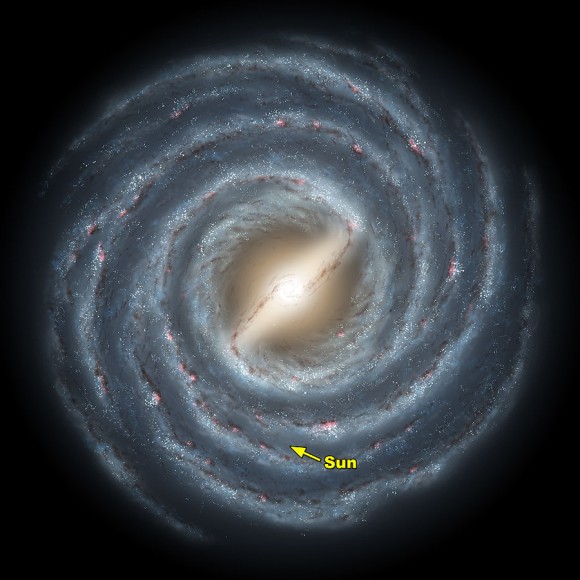The Answer
Yes, the Sun
does rotate. We can observe this by observing
sunspots. All sunspots move across the face of the Sun.
This motion is part of the general rotation of the Sun
on its axis. Observations also indicate that the Sun does
not rotate as a solid body, but it spins differentially.
That means that it rotates faster at the equator of the Sun and slower
at its poles. (The gas giants Jupiter and Saturn also have
differential rotation.) The movements of the sunspots
indicate that the Sun rotates once every 27 days at the
equator, but only once in 31 days at the poles.
 Sun Orbit:-
Everything’s orbiting something it seems. The Moon goes around the Earth, and the Earth orbits the Sun. But did you know that the Sun orbits the Milky Way galaxy?
Astronomers have calculated that it takes the Sun 226 million years to completely orbit around the center of the Milky Way. In other words, that last time that the Sun was in its current position in space around the Milky Way, dinosaurs ruled the Earth. in fact, this Sun orbit has only happened 20.4 times since the Sun itself formed 4.6 billion years ago.
Since the Sun is 26,000 light-years from the center of the Milky Way, it has to travel at an astonishing speed of 782,000 km/hour in a circular orbit around the Milky Way center. Just for comparison, the Earth is rotating at a speed of 1,770 km/h, and it’s moving at a speed of 108,000 km/h around the Sun.
It’s estimated that the Sun will continue fusing hydrogen for another 7 billon years or so. In other words, it only has another 31 orbits it can make before it runs out of fuel.
Sun Orbit:-
Everything’s orbiting something it seems. The Moon goes around the Earth, and the Earth orbits the Sun. But did you know that the Sun orbits the Milky Way galaxy?
Astronomers have calculated that it takes the Sun 226 million years to completely orbit around the center of the Milky Way. In other words, that last time that the Sun was in its current position in space around the Milky Way, dinosaurs ruled the Earth. in fact, this Sun orbit has only happened 20.4 times since the Sun itself formed 4.6 billion years ago.
Since the Sun is 26,000 light-years from the center of the Milky Way, it has to travel at an astonishing speed of 782,000 km/hour in a circular orbit around the Milky Way center. Just for comparison, the Earth is rotating at a speed of 1,770 km/h, and it’s moving at a speed of 108,000 km/h around the Sun.
It’s estimated that the Sun will continue fusing hydrogen for another 7 billon years or so. In other words, it only has another 31 orbits it can make before it runs out of fuel.
Everything’s
orbiting something it seems. The Moon goes around the Earth, and the
Earth orbits the Sun. But did you know that the Sun orbits the Milky Way
galaxy?
Astronomers have calculated that it takes the Sun 226 million years
to completely orbit around the center of the Milky Way. In other words,
that last time that the Sun was in its current position in space around
the Milky Way, dinosaurs ruled the Earth. in fact, this Sun orbit has
only happened 20.4 times since the Sun itself formed 4.6 billion years
ago.
Since the Sun is 26,000 light-years from the center of the Milky Way,
it has to travel at an astonishing speed of 782,000 km/hour in a
circular orbit around the Milky Way center. Just for comparison, the
Earth is rotating at a speed of 1,770 km/h, and it’s moving at a speed
of 108,000 km/h around the Sun.
It’s estimated that the Sun will continue fusing hydrogen for another
7 billon years or so. In other words, it only has another 31 orbits it
can make before it runs out of fuel.
Read more:
http://www.universetoday.com/18028/sun-orbit/#ixzz2CUezzwOH
Everything’s
orbiting something it seems. The Moon goes around the Earth, and the
Earth orbits the Sun. But did you know that the Sun orbits the Milky Way
galaxy?
Astronomers have calculated that it takes the Sun 226 million years
to completely orbit around the center of the Milky Way. In other words,
that last time that the Sun was in its current position in space around
the Milky Way, dinosaurs ruled the Earth. in fact, this Sun orbit has
only happened 20.4 times since the Sun itself formed 4.6 billion years
ago.
Since the Sun is 26,000 light-years from the center of the Milky Way,
it has to travel at an astonishing speed of 782,000 km/hour in a
circular orbit around the Milky Way center. Just for comparison, the
Earth is rotating at a speed of 1,770 km/h, and it’s moving at a speed
of 108,000 km/h around the Sun.
It’s estimated that the Sun will continue fusing hydrogen for another
7 billon years or so. In other words, it only has another 31 orbits it
can make before it runs out of fuel.
Read more:
http://www.universetoday.com/18028/sun-orbit/#ixzz2CUezzwOH
 Sun Orbit:-
Sun Orbit:- 




0 comments:
Post a Comment
IT'S YOUR TURN...
To respond : Drop in just anything but spam. Please don't drop comments just to add your link here. You can use basic HTML tags.
Important : If you're looking for further clarification, advice or support, please address by comment.